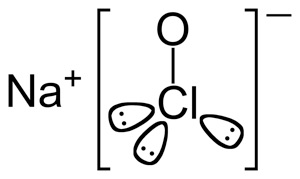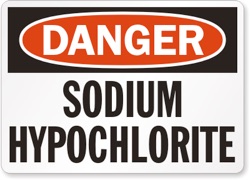Bleaching

Using bleach to remove dye from eggs is a quick and easy way of getting the eggshell back to white quickly. Bleach works not by actually removing the dye from the shell, or removing a layer of the shell (etching), but by “breaking” the dyes themselves.
Sodium hypochlorite (ordinary laundry bleach) is an oxidizing bleach; it works by breaking the chemical bonds that make up the chromophore, a group of atoms and electrons forming part of an organic molecule that causes it to be colored (reflect light). This changes the molecule into a different substance that either does not contain a chromophore, or contains a chromophore that does not absorb visible light.
What does that mean? The dye molecules are still there, just invisible. It is a chemical cloak of invisibility!
Note: Bleach will dissolve the egg's interior membrane, but, unlike acid, will not dissolve the shell.
PROCESS: Bleaching the egg is fairly simple. Just put the egg in a solution of bleach (a few tablespoons to a cup of water), and watch the color disappear as if by magic. The bleach does make the egg slippery, though--rinse it under cold water until it is no longer slippery, and then let it sit and dry for at least half an hour.
Alternatively, you can clean the egg first with Ivory or Simple Green to remove as much dye as possible, before submerging the shell in a 50/50 solution of bleach and water. Leave it in for only 10 seconds. then take it out and set it on a newspaper or paper towel to dry. Don’t actively dry it. After 10 or 15 minutes, the shell should be white and dry.
DYEING: Bleach can also have undesirable effects. One is that is affect the cuticle, rendering it unsuitable for dyeing. The oxidation is not limited to the dye, but he proteins in the cuticle can be disrupted, too. I do not try to dye after bleaching, but reserve this method for eggs meant to have a white background (and will confess to not bleaching at all in many, many years).
If you do wish to try and dye further, after bleaching, clean the egg off with water and Ivory liquid, and rinse well. Then dip the egg into vinegar to neutralize any remaining bleach molecules and reset the pH of the shell, and let it dry completely. Some people suggest letting it rest for a few days, others say an hour is fine. This resting period seems to be important, though.
WAX REMOVAL: bleach can change the consistency of a shell, so removing wax afterwards can be problematic. Some recommend using a solvent like Goo Gone or mineral spirits to remove the wax; drenching the egg in cooking oil (as you would do for an etched shell) can help, too. In either case, you should let the egg dry thoroughly before removing the wax, at least overnight.
YELLOWING: bleached eggs, particularly the white areas, have a tendency to yellow over time. I do not know why this happens, but it happens with white fabrics that are bleached, too.
Back to Main Dyeing page
Back to Main Advanced Dyeing page
Back to Main Pysankarstvo page
Search my site with Google
Sodium Hypochlorite






